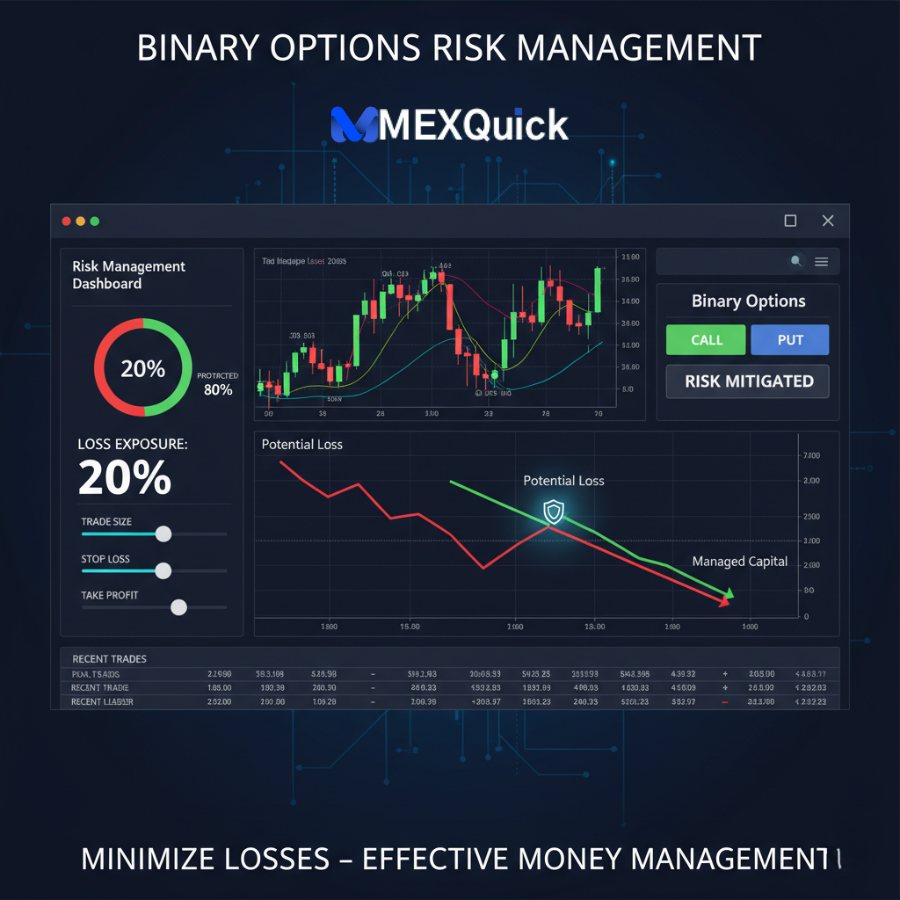
I’ll let you in on a secret that most binary options “gurus” won’t tell you: the single biggest difference between a successful trader and someone who blows up their account isn’t a secret signal—it’s risk management in Binary options.
Think about it. You can have a strategy that’s right 60% of the time, but if you risk $100 on every losing trade and only $50 on every winner, you’ll still go bankrupt. It’s simple math.
The harsh reality is that many brokers report that a significant percentage of retail traders lose money, often citing figures like 70-80%. The primary cause? A near-total lack of Binary options loss prevention.
But that doesn’t have to be you. This article isn’t about finding a “winning trade.” It’s about building an unbreakable system to protect your capital, so you can trade another day. I’m going to give you the concrete, actionable rules for how to manage trading risk like a professional. Let’s turn you from a gambler into a risk manager.
Why Risk Management is Your #1 Trading Skill
You might think trading is about being right. In reality, it’s about not being wrong in a catastrophic way. Effective money management strategies are the shield that protects you from yourself—from emotion, greed, and impulsive decisions.
Here’s the core principle: Preservation of capital is more important than growth. Your first job is to protect what you have. Consistent profits are a byproduct of excellent defense, not just a good offense.
Without a risk management plan, you are:
- Chasing Losses: Doubling down after a loss to “get back to even,” which often leads to even greater losses.
- Risking Too Much: Putting a huge portion of your account on one “sure thing,” which never is.
- Trading Emotionally: Making decisions based on fear and greed rather than logic.
The 5 Pillars of Unbeatable Binary options Risk Management
These five rules are non-negotiable. Implement them starting with your very next trade.
1. The 1-5% Rule: The Foundation of Survival
This is the golden rule. Never risk more than 1-5% of your total trading capital on a single trade.
- Why it works: Even if you hit a losing streak of 5 or 10 trades in a row (which happens to every trader), you will still have most of your capital intact to recover.
- Example: If you have a $1,000 account, your maximum risk per trade is between $10 and $50. If you lose 5 trades in a row at 5% each, you still have $750 left. If you risked 25% per trade, you’d be down to zero after 4 losses.
2. The Risk/Reward Ratio: Make the Math Work in Your Favor
Most binary options have a fixed payout, typically between 70-90%. This means your potential win is always less than your potential loss. Therefore, your win rate must be high enough to be profitable.
- The Calculation: If a broker offers an 80% payout, you risk $100 to make $80. To break even, you need a win rate of 55.5%. (You can find calculators online for this).
- Actionable Tip: Know your numbers. If your strategy only wins 50% of the time, you will lose money over the long run with an 80% payout. You must either improve your strategy’s accuracy or find a broker with a higher payout.
3. Position Sizing: Don’t Put All Your Eggs in One Basket
This rule extends the 1% rule. It’s about not having too much capital exposed to a single idea at one time.
- The Rule: Limit your total exposure to 10-15% of your capital at any given time. If you have three open trades, and you risk 3% on each, your total exposure is 9%. This prevents a single market event from wiping out a large chunk of your account.
4. Use a Stop-Loss (Even if it’s Mental)
Binary options are an all-or-nothing bet by nature. However, a “mental stop-loss” means you have a predefined point where you admit the trade is wrong.
- How it works: Before you enter, decide what market movement would invalidate your trade idea. If the price hits that level before expiry, you mentally close the trade (by taking an opposite option to hedge, if your platform allows, or simply by accepting the loss and analyzing what went wrong). This prevents you from holding onto hope on a losing trade.
5. The Daily Loss Limit: Know When to Walk Away
This is the ultimate circuit breaker. Set a hard limit on how much you can lose in a single day.
- Actionable Tip: A common rule is 5-10% of your account. If you start with $1,000 and set a 5% daily loss limit ($50), you must stop trading for the day once you hit that loss. Close the platform. Walk away. This prevents “tilting”—the emotional state where you make bad decisions to recover losses, which only digs a deeper hole.
Building Your Risk Management Plan: A Step-by-Step Example
Let’s make this practical. Here’s how a trader, Sarah, implements these rules.
- Account Balance: $2,000
- Risk-Per-Trade (1-5% Rule): She chooses a conservative 2%. Her max risk per trade is $40.
- Daily Loss Limit: She sets a strict 5% daily limit. If she loses $100 in a day, she stops trading.
- Executing a Trade: She identifies a potential trade on Gold. Her analysis suggests a 70% probability of success. She places a trade with a $40 investment. If she wins, she makes a $32 profit (assuming an 80% payout). If she loses, she loses $40.
- Review: At the end of the week, she reviews her journal. She had 12 trades: 7 wins ($224 profit) and 5 losses ($200 loss). Her net profit is $24. It’s small, but it’s profitable and sustainable.
The Psychological Battle: Sticking to Your Plan When It Gets Tough

The hardest part of risk management in Binary options isn’t understanding the rules—it’s following them when you’re down $100 and want to make it back quickly.
- Emotion is the Enemy: Greed tempts you to risk more after a win. Fear tempts you to break your stop-loss after a loss.
- The Solution: Discipline. Your trading plan is a contract you make with yourself. Trust the process, not your gut feeling in the heat of the moment.
Conclusion: Your Blueprint for Longevity
Let’s be clear: Binary options loss prevention is not sexy. It’s not about the thrill of a big win. It’s about the quiet confidence of knowing you have a system that protects you from ruin.
Here’s your actionable summary for how to manage trading risk:
- Cap Your Risk: Never bet more than 1-5% of your account on one trade.
- Know Your Numbers: Understand the win rate needed for your broker’s payout structure.
- Set Hard Limits: Implement a daily loss limit and stick to it without exception.
- Trade with a Plan, Not a Hope: Every entry must have a predefined exit point.
Your mission now is simple: Before you place another trade, open a spreadsheet or a notebook and write down your personal risk management rules. What is your risk-per-trade? What is your daily loss limit? Sign it. This is your most important trade ever.
What’s the hardest risk management rule for you to follow? Is it the daily limit or the risk-per-trade? Share your biggest challenge in the comments below—let’s learn from each other. If this guide gave you a clearer path, please share it with a fellow traders.
